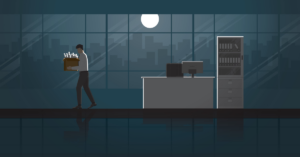In business, disruption describes a process whereby an innovation fundamentally and indelibly changes an industry. It changes how incumbent companies in the industry must operate. It changes how entrants can move their way up in a market. And it reorients the consumer imagination of what’s possible from the industry.
Classic examples of disruption include the personal computer and smartphone, each ushering massive changes in the software industry. In the 21st century, you will find headline-grabbing examples of disruption like Uber, Netflix and Airbnb (disrupting the transportation, entertainment and hospitality industries, respectively). And in the past few years, Nobul has disrupted the real estate industry.
Using these examples, let’s explore what Steven Sinofsky describes as “The Four Stages of Disruption,” a quasi-predictable pattern that reveals how disruptive innovations take hold – and why they are so potent.
Stage 1: Disruption of Incumbent
This is the “big bang,” so to speak: the moment when an innovative new product or service emerges onto the market. As it enters the market, it stands in opposition with the currently dominant product or service, which is ingrained, mainstream and decidedly satisfactory. In other words, the current offering is popular, and people put up with its flaws for lack of alternatives.
The innovative new offering gains a small foothold. It introduces a better product or easier service. As Nobul’s Regan McGee puts it to Superb Crew, “Anytime you bring innovative technology to the table that can make the process easier, it will be viewed as disruptive.”
At this stage, the disruptive offering hasn’t been widely adopted. Instead, you hear about it through murmurs – chatter in the industry of a massive change on the horizon.
Stage 2: Rapid Linear Evolution
If Stage 1 was the big bang, this is the formation of the stars and galaxies. It’s the period in a disruptor’s lifecycle when they begin climbing rapidly in the market, witnessing rapid adoption and impressive growth.
As the disruptor gains momentum, they start developing their product for its grand debut in the public eye. The focus, according to Sinofsky, becomes “filling out” the product or service.
As an entrant, the disruptive idea might have been rough, or the company itself might have skated by on a ragtag operation. As the disruptive company evolves, it needs to rip pages from the incumbents’ playbook and start operating like an established company. Meanwhile, incumbents need to rip a page from the disruptors and either get on board with the radical changes, or risk being left behind.
Stage 3: Appealing Convergence
At this stage, the industry begins to redefine itself around the innovation. Meanwhile, the disruptive innovation itself undergoes a subtle but noticeable evolution.
Uber’s disruption of the taxi cab industry offers a helpful window into understanding this stage. As Uber propelled into widespread popularity, taxis in major cities felt the pressure to issue their own on-demand apps, and lower the prices they enjoyed as a monopoly. At the same time, Uber evolved in small but significant steps, adding services like Uber XL, Uber Pool and a luxury Uber Black service.
Stage 4: Complete Reimagination
As the disruptive innovation reaches full maturity, it gives way to new innovations. New entrants begin to rethink the industry, this time using the disruptive innovation as its baseline.
Some experts consider this stage a new disruption entirely, while others consider it a continuation of the principal disruption. In any case, some experts contend that the original incumbents have a leg up in this stage; they witnessed the initial disruption, have a strong frame of reference for its emergence, and were agile enough to adapt – so what’s another innovation? You can point to entertainment industry incumbents like HBO and Disney launching their own streaming platforms, as Netflix, the original disruptor, struggles to continue attracting top-level content creators.
Understanding the lifecycle of disruption can help new businesses flourish – and established ones adapt. It can also help us describe an increasingly common phenomenon in business, a disruptive process that we’re sure to see play out many more times in the future.







![Read more about the article [Funding alert] Fintech startup Karbon Card raises capital from Y Combinator](https://blog.digitalsevaa.com/wp-content/uploads/2021/08/Imageqqjk-1630306243714-300x150.jpg)


